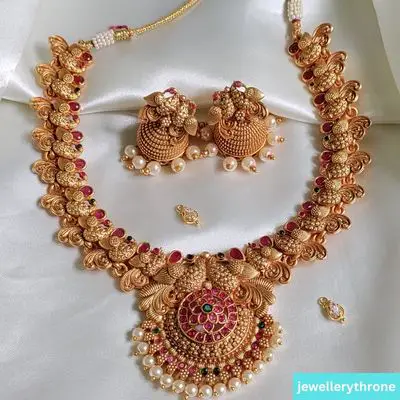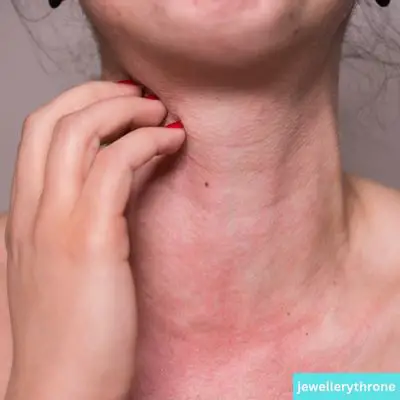Gold plated jewelry may not always be hypoallergenic as it depends on the base metal used. Gold plated jewelry has become increasingly popular due to its affordability and attractive appearance.
However, some people with sensitive skin may experience allergic reactions when they wear gold plated jewelry. The reason being, the base metal used can often cause skin irritation. If you are someone who loves wearing jewelry but is prone to skin allergies, you may wonder if gold plated jewelry is hypoallergenic.
This article aims to provide you with a comprehensive answer to this question Is Gold Plated Hypoallergenic to help you make an informed decision before buying any gold plated jewelry.
The Popularity Of Gold Plating And Its Concerns

Gold plating is a popular method used to adorn jewelry, watches, and other decorative items with gold. This practice has become a sought-after alternative to solid gold and is more affordable while still offering the appearance of a pricey, luxurious metal.
However, there are concerns surrounding gold plating, mainly regarding its hypoallergenic properties and the legitimacy of the “hypoallergenic” label.
Gold Plating In Jewelry
Gold plating is a process that involves coating a base metal, such as copper or brass, with a layer of gold through a process called electroplating. This results in a thin layer of gold that provides a pleasing aesthetic appearance similar to solid gold jewelry.
However, it’s important to note that not all gold-plated jewelry is the same, and the thickness of the gold coating can vary from piece to piece.
Skin Irritation And Allergies
The drawback of gold plating is the possibility of skin irritation and allergies. Most reactions occur in people with sensitive skin or who are allergic to metals such as nickel. The skin irritation can present as rashes, redness, or itching in the areas where the metal is in direct contact with the skin.
It is crucial to note that the thickness of the gold plating is not an indicator of its hypoallergenic properties.
The Hypoallergenic Label
The federal government doesn’t regulate or control the use of the term “hypoallergenic,” which implies that a product is less likely to cause an allergic reaction. This lack of control has created confusion and found some jewelry manufacturers abusing the term’s use.
Don’t assume that because a piece of jewelry is hypoallergenic, you won’t have a reaction, and be careful not to confuse gold plating’s hypoallergenic properties with that of solid gold.
The Need For Unbiased Information
To make an informed decision about gold-plated jewelry, it’s important to have access to unbiased information. With the popularity of gold plating, the market has been flooded with misinformation and exaggerated claims, leading many consumers to make the wrong decisions when it comes to buying jewelry.
Seek reputable sources when searching for information about hypoallergenic jewelry, and don’t be swayed by the “hypoallergenic” label without doing your research.
Related Article : How to Wear Jewellery with Hijab?
The Gold Plating Process

Understanding The Gold Plating Process
Gold plating is the process through which a thin layer of gold is applied to another material. There are a few different methods available for gold plating, but the most common techniques include electroplating and electroless plating. Here are some key things to understand about the gold plating process:
- During electroplating, a negatively charged gold solution is used to draw positively charged gold ions onto the material being plated.
- Electroless plating, on the other hand, uses a chemical reaction to deposit the gold layer onto the material.
- Both methods require careful preparation of the surface being plated to ensure the best possible adhesion and durability of the gold layer.
Materials Used In Gold Plating
The materials used for gold plating can vary depending on the method being used, but generally, they include:
- A solution containing gold ions to be deposited
- A container for the solution
- A substrate to be plated (such as metal, plastic, or ceramic)
- Electrical contacts or other machinery to complete the plating process
- Chemicals to prepare the surface of the substrate before plating
How Thick Is The Gold Layer?
The thickness of the gold layer applied during the plating process can also vary but typically ranges from micro-inches to tens of micrometers. The thickness of the layer can affect the overall quality and durability of the plated material. Generally, thicker gold layers are more durable and resistant to wear and corrosion.
How Long Does Gold Plating Last?
The lifespan of gold plating depends on several factors, including the thickness of the gold layer, the quality of the plating method used, and how the plated material is used and cared for. In general, higher-quality gold plating can last for several years with proper care and maintenance.
However, the plated layer will eventually wear away with regular use and exposure to the elements, revealing the underlying substrate material.
Related Article : Why Guys Should not Wear Earrings?
The Science Of Allergies

Allergies are a common medical condition that affect millions of people worldwide. They occur when the immune system reacts to a particular substance, known as an allergen, that is normally harmless to the body. In the case of gold plated jewelry, the allergen is generally nickel, which is often used as a base metal beneath the gold plating.
So, Is Gold Plated Hypoallergenic? Let’s look into that in the following sections.
What Causes Allergies?
Symptoms of allergies are caused by the immune system reacting too strongly to a particular substance. The immune system sees the substance as harmful, even though it is not, and produces an allergic reaction. In the case of gold plated jewelry, the culprit is often nickel.
When nickel is in contact with skin, it can cause an allergic reaction. However, it’s important to note that not everyone is allergic to nickel, and that some people may even be allergic to gold itself.
What Are The Symptoms?
Symptoms of an allergic reaction to gold plated jewelry can range from mild to severe. Itching, redness, and swelling can occur at the site of contact with the jewelry. In some cases, blisters may develop, which can be painful and slow to heal.
In severe cases, an allergy to gold plated jewelry can cause a generalized rash or even anaphylaxis, which is a life-threatening allergic reaction.
Differentiating Allergies From Irritation
It’s important to note that an allergic reaction to gold plated jewelry is different from simple irritation. Irritation can occur when the skin is in contact with a substance that causes a non-allergic reaction, such as a metal that does not contain nickel.
The symptoms are similar to an allergic reaction but are generally less severe and often go away once the irritant is removed.
Allergic Reactions To Metals
Gold plated jewelry can cause an allergic reaction in some people due to the presence of nickel. However, other metals commonly found in jewelry can also cause an allergic reaction, including:
- Silver
- Copper
- Brass
- Platinum
- Palladium
If you suspect that you may be allergic to a particular metal, it’s best to avoid jewelry made with that metal. Instead, opt for hypoallergenic metals like titanium or stainless steel.
While gold itself is generally hypoallergenic, gold plated jewelry may cause an allergic reaction in some people due to the presence of nickel. If you suspect that you may be allergic to nickel or another metal commonly found in jewelry, it’s best to avoid these metals and opt for hypoallergenic options instead.
Related Article : Are Bamboo Earrings Cultural Appropriation?
The Link Between Gold Plating And Allergies

Gold Plated Hypoallergenic: The Link Between Gold Plating And Allergies
Have you ever experienced red and itchy skin after wearing jewelry? If yes, then you might be allergic to some metals. The most common metal allergies are caused by nickel and copper. However, gold jewelry has also been known to cause allergic reactions.
We explore the link between gold plating and allergies.
Gold Alloys And Their Effects On Allergies
Pure gold is a soft metal, which is why it is often alloyed with other metals to increase its durability and strength. Unfortunately, some of these alloyed metals (such as nickel and copper) can cause allergic reactions in some people.
The amount of metal present in the alloy varies from piece to piece, so it can be difficult to predict whether or not a certain piece of gold jewelry will cause an allergic reaction.
Factors That Affect Allergic Reactions
Several factors can influence whether or not someone will have an allergic reaction to gold jewelry. These include:
- Individual sensitivity to metals
- The amount of time the jewelry stays on your body.
- The amount of metal present in the jewelry is measured.
- Other allergens present in the environment
Skin Sensitivity And Allergies
The skin is the body’s first line of defense against foreign substances, and some people have particularly sensitive skin. If you have sensitive skin, you may be more likely to experience an allergic reaction to gold jewelry.
Types Of Gold Plated Metals
There are several types of gold plated metals, each with its own unique characteristics.
- Gold vermeil (pronounced ver-may) is a type of gold plating that uses sterling silver as the base metal. It is thicker and more durable than other types of gold plating, which makes it less likely to wear off and cause an allergic reaction.
- Gold-filled and rolled gold are made by bonding a thin layer of gold to a base metal using heat and pressure. The amount of gold used in these processes can vary, which means that they have varying levels of resistance to tarnishing and causing allergic reactions.
- Gold plated jewelry is made by coating a base metal with a thin layer of gold. The thickness of the gold coating and the base metal used can vary, which can affect its resistance to tarnishing and causing allergic reactions.
While gold jewelry can be beautiful and long-lasting, it can also cause allergic reactions in some people. If you suspect that you have a sensitivity to gold or other metals, consider choosing jewelry made from hypoallergenic materials, such as platinum or titanium.
Remember to read product labels carefully and ask questions if you are unsure about the metal content of a piece of jewelry.
Related Article : Are Feather Earrings Cultural Appropriation?
How To Choose Hypoallergenic Jewelry

Is Gold Plated Hypoallergenic
When it comes to jewelry, choosing the right metal is essential for people with sensitive skin. While gold-plated jewelry is a popular choice, it may not always be hypoallergenic. We will discuss how to choose hypoallergenic jewelry and the importance of understanding labels and certificates.
Understanding Labels And Certificates
Before purchasing any jewelry, it is important to check if it is hypoallergenic. Here are some labels and certificates to look for:
- Nickel-free: Nickel is a common metal used in jewelry that can cause allergic reactions. Jewelry labeled as “nickel-free” indicates that the item doesn’t contain any nickel.
- Surgical-grade stainless steel: This metal is often used in medical implants and is hypoallergenic. Jewelry labeled as “surgical-grade stainless steel” indicates that the item won’t cause any allergic reactions.
- Certificates of authenticity: Bulova, citizen, and movado are a few well-known brands that offer certificates of authenticity. These certificates indicate that the jewelry is made of high-quality materials and is hypoallergenic.
Choosing The Right Type Of Metal
Not all metals are suitable for people with sensitive skin. Here are some hypoallergenic options to consider:
- Platinum: This rare metal is hypoallergenic, making it an excellent choice for sensitive skin. It is also durable and retains its shine for a long time.
- Titanium: Jewelry made from pure titanium is hypoallergenic and lightweight. It is also resistant to scratches and corrosion.
- Fine silver: Sterling silver can contain small amounts of nickel, which may cause allergies. Fine silver, on the other hand, is 99.9% pure and hypoallergenic.
Testing For Allergies
Before purchasing any jewelry, it is important to test it for allergies. In the below, Here are some tips to how you can do it at home:
- Apply a small amount of the jewelry to your skin, preferably on your wrist or neck.
- Wait for at least 24-48 hours. If there is no redness, itching, or irritation, then the jewelry is safe for use.
Maintaining Your Jewelry
Taking care of your jewelry is essential for its longevity and hypoallergenic properties. Here are some tips:
- Remove your jewelry before swimming or showering to avoid exposure to chlorinated water.
- Use a soft cloth to clean your jewelry regularly, and avoid using abrasive cleaners.
- In a dry and cool place, store your jewelry.
Choosing hypoallergenic jewelry is essential for people with sensitive skin. By understanding labels and certificates, choosing the right type of metal, testing for allergies, and maintaining your jewelry, you can ensure that your jewelry is safe and hypoallergenic.
Related Article : What Earring Look Good on Guys?
Frequently Asked Questions
Is Gold Plated Hypoallergenic?
Yes, gold plated jewelry is considered hypoallergenic since the metal used for plating is usually a non-reactive metal like nickel or brass. However, if the plating wears off and the base metal is exposed, it may cause an allergic reaction.
What Causes Allergic Reactions To Gold Plated Jewelry?
Allergic reactions to gold plated jewelry are usually caused by the base metal used for the jewelry, such as nickel or brass. When the plating wears off and the skin comes into contact with the base metal, it can cause an allergic reaction.
Can People With Sensitive Skin Wear Gold Plated Jewelry?
Yes, people with sensitive skin can usually wear gold plated jewelry. The non-reactive metal used for plating makes it hypoallergenic. However, it’s important to pay attention to the base metal used for the jewelry to prevent any allergic reactions.
How Long Does Gold Plating Last On Jewelry?
The longevity of gold plating depends on various factors, such as the thickness of the plating and the amount of wear and tear. However, with proper care, gold plating can last for years before it begins to wear off.
How Do I Care For Gold Plated Jewelry?
To care for gold plated jewelry, it’s important to avoid exposing it to water, sweat, and chemicals. Clean it regularly by using soft cloth and store it in a dry place. Avoid wearing the jewelry during activities that may cause it to become damaged.
Conclusion
After thoroughly discussing the subject of, Is Gold Plated Hypoallergenic? It is apparent that gold-plated jewelry can be hypoallergenic, but it depends on various factors such as base metal used, quality of gold plating, and a person’s individual skin reaction. Pure gold is a safe metal to wear for people with sensitive skin, but it is expensive.
Gold-plated jewelry, on the other hand, can provide a more affordable option, but it is crucial to check the quality and thickness of the gold plating. In general, it is essential to buy jewelry from reputable sources, buy high-quality products, and take recommended care to prevent allergic reactions.
Gold plated jewelry can be hypoallergenic, but it is not a one-size-fits-all solution. It is essential to educate oneself, research, and take precautions before purchasing any jewelry to avoid any potential allergic reactions or skin irritations.

Hi, my name is Sagor Jahan. I am an expert person in the Jewellery industry especially earrings. I am working on this sector for nearly 7 years. I opened this website for you so that I can help you to know the unknown and choose the right products.
